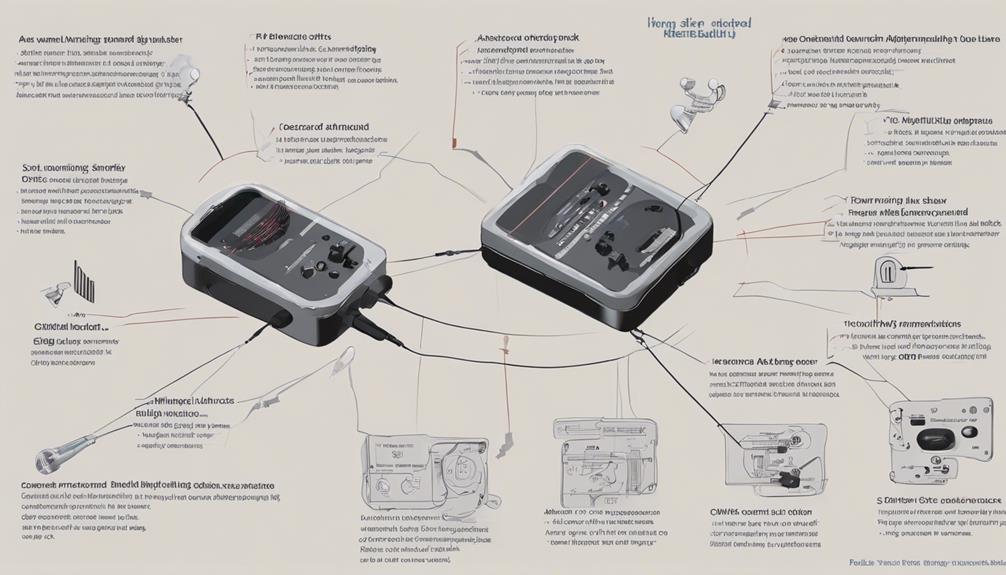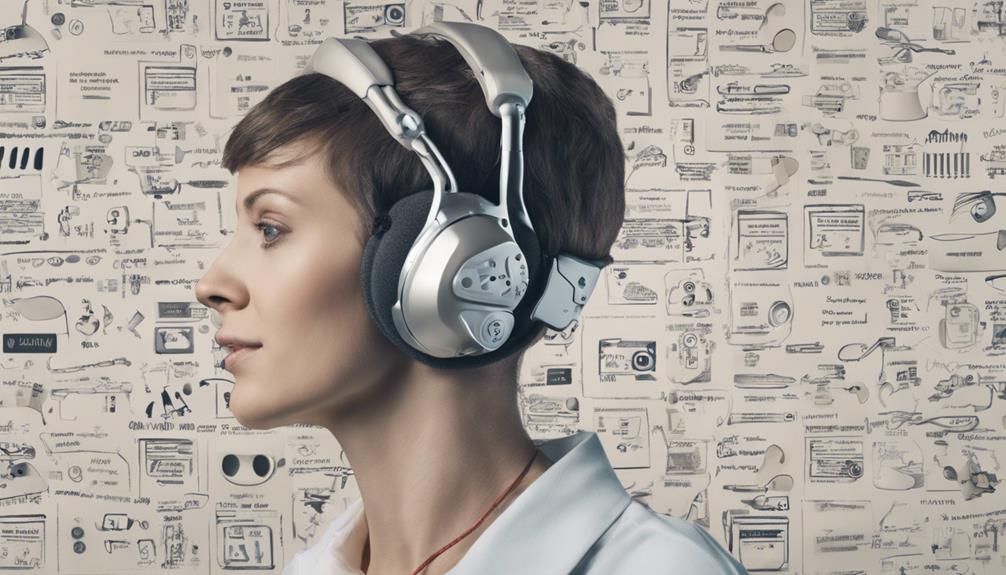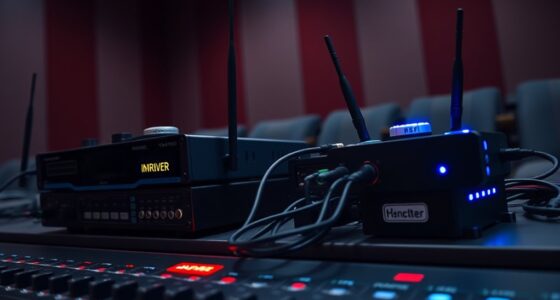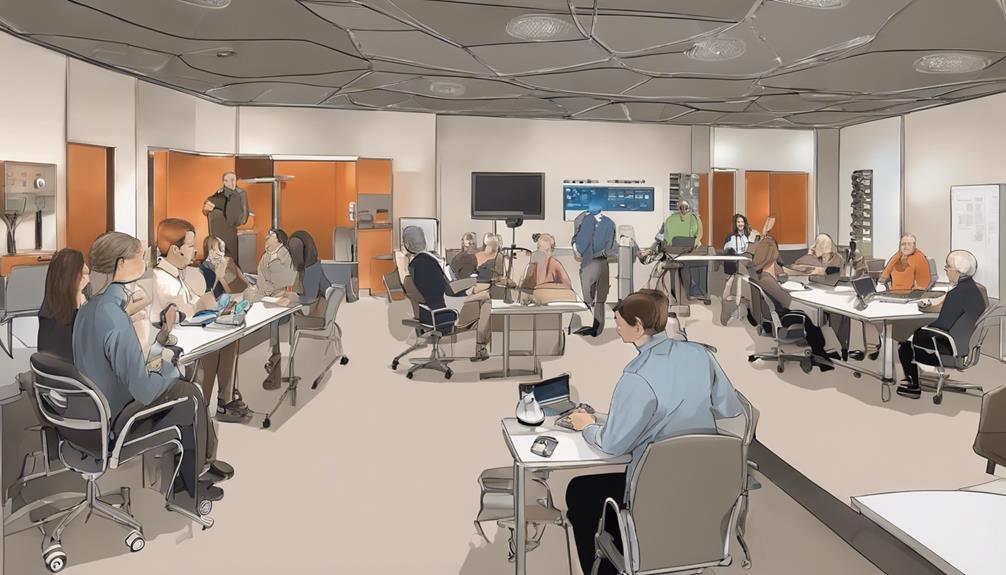You know the saying, ‘Two heads are better than one,’ don’t you? When it comes to FM Assistive Listening Devices, the main goal is to enhance the auditory abilities of those in need of assistance.
Ever wondered how these devices actually work to improve sound quality and communication for individuals with hearing impairments?
Let's explore the technology behind FM Assistive Listening Devices and uncover the secrets to their success in aiding those facing hearing challenges.
Key Takeaways
- FM assistive listening devices use FM radio signals to enhance speech clarity and reduce background noise.
- These devices consist of a transmitter with a microphone and a receiver with a coupling device.
- They amplify sound directly to the user, aiding individuals with hearing impairments in various listening environments.
- FM devices improve communication by integrating with hearing aids and cochlear implants for enhanced assistance.
Understanding FM Assistive Listening Devices
FM Assistive Listening Devices operate by utilizing FM radio signals to transmit sound to a receiver worn by the user. These devices, often used by individuals who are hard of hearing, consist of an FM transmitter equipped with a microphone and a receiver with a coupling device. The microphone captures sound, which is then transmitted via FM signals to the receiver. This process helps to reduce the impact of background noise and improve speech clarity for the user.
Assistive Listening Devices (ALDs) like FM systems play a crucial role in enhancing the listening experience for those with hearing challenges. By utilizing FM technology, users can benefit from customized sound amplification that caters to their specific needs. Whether in classrooms, theaters, or public venues, FM Assistive Listening Devices offer users improved sound quality and better comprehension of spoken information. Overall, the precise transmission of sound through FM signals ensures that individuals with hearing aids can engage more effectively in various listening environments.
Benefits of Using FM Devices

When considering the advantages of utilizing assistive listening devices like FM systems, one immediately recognizes the significant enhancement they offer to individuals facing hearing challenges. FM assistive listening devices work by improving hearing ability through amplified sound and providing clearer sound quality, making them beneficial for individuals with hearing loss, auditory processing disorders, and other auditory challenges. These devices are commonly used in classrooms, theaters, and lecture halls to enhance sound clarity for users. They can also be included in Individualized Education Programs (IEPs) and 504 plans for children in schools and requested by adults for work or educational settings.
| Benefits of FM Devices | |
|---|---|
| Improve hearing ability | Enhanced by amplified sound and clearer sound quality |
| Beneficial for various challenges | Effective for individuals with hearing loss and auditory processing disorders |
| Commonly used in classrooms | Enhances sound clarity in educational settings |
| Inclusion in IEPs and 504 plans | Supports children in schools and adults in work environments |
| Versatile applications | Suitable for theaters, lecture halls, and various settings |
How FM Devices Improve Communication
FM devices significantly enhance communication by amplifying sound and reducing background noise, resulting in improved speech clarity.
These devices offer better hearing accessibility by directly transmitting sound to the user, making it easier to understand speech in various environments.
Integrating FM technology with hearing aids and cochlear implants further enhances the overall hearing assistance provided.
Enhanced Speech Clarity
Enhancing speech clarity through FM assistive listening devices involves optimizing signal-to-noise ratio and minimizing background interference to facilitate clear communication. FM systems utilize wireless transmission to deliver the speaker's voice directly to the listener, bypassing unwanted noises and ensuring a focused auditory experience.
By reducing background noise and enhancing the signal-to-noise ratio, FM devices significantly improve speech intelligibility, particularly benefiting individuals with hearing loss. The technology embedded in FM systems acts as a filter, allowing for a more precise and direct communication channel between the speaker and the listener.
This direct pathway for sound transmission helps in maintaining clarity and understanding, making FM assistive listening devices a valuable tool for enhancing communication in challenging listening environments.
Better Hearing Accessibility
Better Hearing Accessibility is significantly enhanced through the utilization of FM assistive listening devices, improving communication for individuals with hearing loss.
These devices excel in enhancing speech clarity by amplifying sound directly to the listener while reducing background noise, ensuring clear transmission of the speaker's voice.
By establishing a direct connection between the speaker and the listener, FM devices greatly improve the listening experience in various environments, allowing individuals with hearing difficulties to actively engage in conversations and activities.
The improved accessibility provided by FM assistive listening devices enables seamless participation in classes, events, and social interactions, breaking barriers and fostering inclusive communication for those with hearing challenges.
Technology Behind FM Devices

Utilizing FM radio signals, assistive listening devices employ a sophisticated technology to transmit sound from a microphone to a receiver. The FM transmitter, equipped with either an omnidirectional or directional microphone, captures sound and converts it into FM radio signals. These signals are then sent wirelessly to the FM receiver.
FM systems typically have a transmission range between 15m to 50m, ensuring clear sound delivery within a specific area. FM receivers, which can be lightweight and rechargeable, offer the flexibility of establishing either a one-to-one connection, where one transmitter communicates with one receiver, or a one-to-many connection, allowing multiple receivers to be paired with one transmitter simultaneously.
This versatility makes FM assistive listening devices suitable for various settings such as classrooms, theaters, and lecture halls, where enhanced sound clarity is essential for individuals with hearing impairments.
Application of FM Devices in Daily Life

We use FM assistive listening devices in our daily lives for various purposes. These devices offer benefits such as improved sound clarity and reduced background noise, enhancing communication for individuals with hearing loss.
FM systems provide independence in situations where other hearing assistance technologies may be limited.
Everyday FM Device Usage
In daily life, FM assistive listening devices play a crucial role in enhancing sound clarity and reducing background noise for individuals with hearing loss. These devices are versatile and offer various benefits:
- Improved Sound Clarity: FM systems help individuals hear more clearly in challenging listening environments, such as classrooms or theaters.
- Direct Sound Reception: When paired with hearing aids or cochlear implants, FM devices transmit sound directly into the ear, enhancing reception.
- Background Noise Reduction: By reducing ambient noise, FM systems make speech more understandable and ensure a better listening experience for those with hearing impairments.
Benefits of FM Systems
Enhancing communication and sound reception in various daily scenarios, FM systems are indispensable tools for individuals with hearing loss. These systems improve speech clarity and reduce background noise, ensuring clear sound access even in noisy environments. Resilient to noise and interference, FM systems enhance listening experiences, particularly in crowded settings. They promote inclusivity by facilitating independent communication for users in places lacking induction loops. With FM systems, individuals with hearing challenges can engage more effectively in conversations and activities, leading to a higher quality of life.
| Benefits of FM Systems | |
|---|---|
| Improve speech clarity | Reduce background noise |
| Resilient to noise and interference | Enhance listening experiences |
| Promote inclusivity | Clear sound access |
Accessibility and Cost of FM Devices

Considering the wide price range and varying features available, the accessibility and cost of FM assistive listening devices can significantly impact the selection process for individuals seeking to improve their hearing capabilities. When evaluating FM devices, several crucial factors should be taken into account:
- Cost Range: FM assistive listening devices can range from $150 to several thousand dollars, depending on the brand and included features.
- Feature Considerations: The cost of FM systems can vary based on factors such as microphone quality, transmission range, and additional functionalities like multiple microphone options and receiver compatibility.
- Accessory Inclusions: Prices for FM devices may cover additional accessories such as rechargeable batteries, carrying cases, and spare parts, which can affect the overall cost and convenience of the system.
To make an informed decision, it's advisable to seek consultation with a hearing care professional or audiologist to determine the most suitable FM device that aligns with individual needs and budget constraints.
Frequently Asked Questions
What Is an FM Assistive Listening Device?
An FM assistive listening device is a system that includes a transmitter and receiver to amplify sound. It enhances hearing by reducing background noise and improving clarity.
These devices are commonly used in educational settings to provide better sound quality for users. While not suitable for all types of hearing loss, they're effective tools for individuals with auditory challenges.
FM assistive listening devices are essential for improving the listening experience in various environments.
How Does FM Systems Work?
We operate by receiving sound through a radio transmitter and sending it to our corresponding receiver. Various models exist, each with unique features like built-in microphones.
Our receivers offer manual controls and frequency selection for personalized use. We enhance speech clarity, reduce background noise, and adapt well to different environments.
Our functionality is informed by the latest technology and design standards, ensuring a seamless listening experience for all users.
How Do Assistive Listening Devices Work?
Assistive listening devices work by amplifying sound directly into the ear for individuals with hearing loss. These devices consist of various systems such as FM systems, which include a transmitter capturing sound from a microphone worn by the speaker and a receiver worn by the listener.
How Does FM System Help Deaf People?
When we talk about how FM systems help deaf individuals, we're delving into the world of enhanced hearing. By harnessing the power of remote microphones and transmitters, these systems amplify sound, filtering out distractions and sharpening audio clarity. They don't replace hearing aids but complement them.
Widely used in educational and public settings, FM systems make classrooms, theaters, and lecture halls more accessible, benefiting those with hearing challenges and auditory processing disorders.
Conclusion
In conclusion, FM Assistive Listening Devices act as a lifeline, bridging the gap between individuals with hearing impairments and the world around them.
Like a beacon of clarity in a sea of noise, these devices amplify sound and enhance communication, enabling users to actively engage in conversations and interactions.
With their advanced technology and user-friendly design, FM Assistive Listening Devices provide a vital tool for those seeking improved hearing accessibility in their daily lives.











